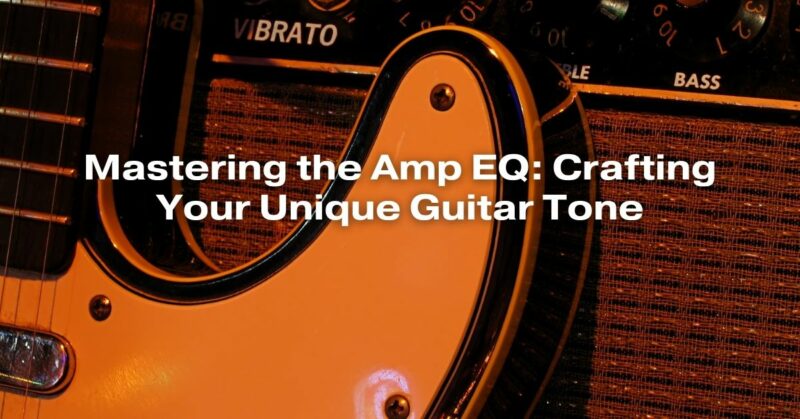The quest for the perfect guitar tone is a never-ending journey for musicians and enthusiasts alike. While the type of guitar, pedals, and pickups play vital roles, mastering the amp EQ is a crucial aspect of sculpting your unique sound. The amplifier is the canvas upon which your musical masterpiece is painted, and understanding how to wield its EQ controls effectively can transform your playing experience. In this article, we will explore the fundamentals of amp EQ, demystify its various components, and guide you through the process of crafting your distinct guitar tone.
Understanding the Basics
Before diving into the intricacies of amp EQ, it’s essential to comprehend the fundamental components:
- Bass: Controls the low-frequency range. Increasing bass adds warmth and thickness to your tone, while decreasing it results in a sharper, tighter sound.
- Mid: Governs the mid-frequency range, affecting the guitar’s presence in the mix. Boosting mids can make your guitar more prominent and articulate, ideal for solos, while cutting them can produce a mellower, vintage tone.
- Treble: Manages the high-frequency range. Raising treble imparts brightness and clarity, enhancing your guitar’s definition. Lowering it creates a darker, smoother tone.
- Presence: Found in some amps, the presence control adjusts the upper midrange frequencies. It influences the overall clarity and sparkle of your sound, making it more or less present in the mix.
Finding Your Signature Sound
- Start Flat: Begin by setting all EQ controls to 12 o’clock (or halfway). This neutral position provides a balanced starting point.
- Experiment with Guitar and Amp Combinations: Different guitars and amplifiers interact uniquely. Single-coil pickups might require a different EQ setting than humbuckers. Experiment with various combinations to understand how they influence your tone.
- Room Acoustics: Consider the acoustics of the room you’re playing in. If it’s a small, reflective space, you might want to reduce treble to avoid excessive brightness. In a larger, absorbent room, increasing treble can enhance clarity.
- Playing Style: Your picking technique and playing dynamics affect your tone. Lighter picking may require a boost in treble for articulation, while heavy picking might benefit from increased bass for depth and sustain.
- Genre-specific Tweaks: Different music genres often have specific tonal requirements. Research the typical amp settings for your preferred genre and use them as a starting point for your experimentation.
Advanced Techniques
- Sculpting Your Lead Tone: For solos, consider boosting mids and treble slightly. This helps your guitar cut through the mix, making your lead lines more prominent and expressive.
- Creating a Warm Clean Tone: To achieve a warm, clean sound, slightly boost bass and mids while keeping treble moderate. This imparts a roundness to your notes without sacrificing clarity.
- Achieving a Crunchy Rhythm: For a classic crunch sound, emphasize mids and treble while keeping bass moderate. This setting adds bite to your chords, making them sound powerful and defined.
- Experimenting with Presence: Presence control, if available, can add an extra dimension to your tone. A subtle increase can enhance high-end clarity, while too much presence might make your sound harsh. Tweak it carefully based on your preference and the room acoustics.
Conclusion
Mastering the amp EQ is an art that requires patience, experimentation, and a keen ear. Your guitar tone is a deeply personal expression of your musical identity, and understanding how to manipulate the amp’s EQ controls empowers you to create a signature sound that resonates with your style. Remember, there are no strict rules; the best tone is the one that sounds perfect to your ears. So, don’t hesitate to explore, tweak, and fine-tune until you discover the tone that truly speaks to you. Happy playing!


